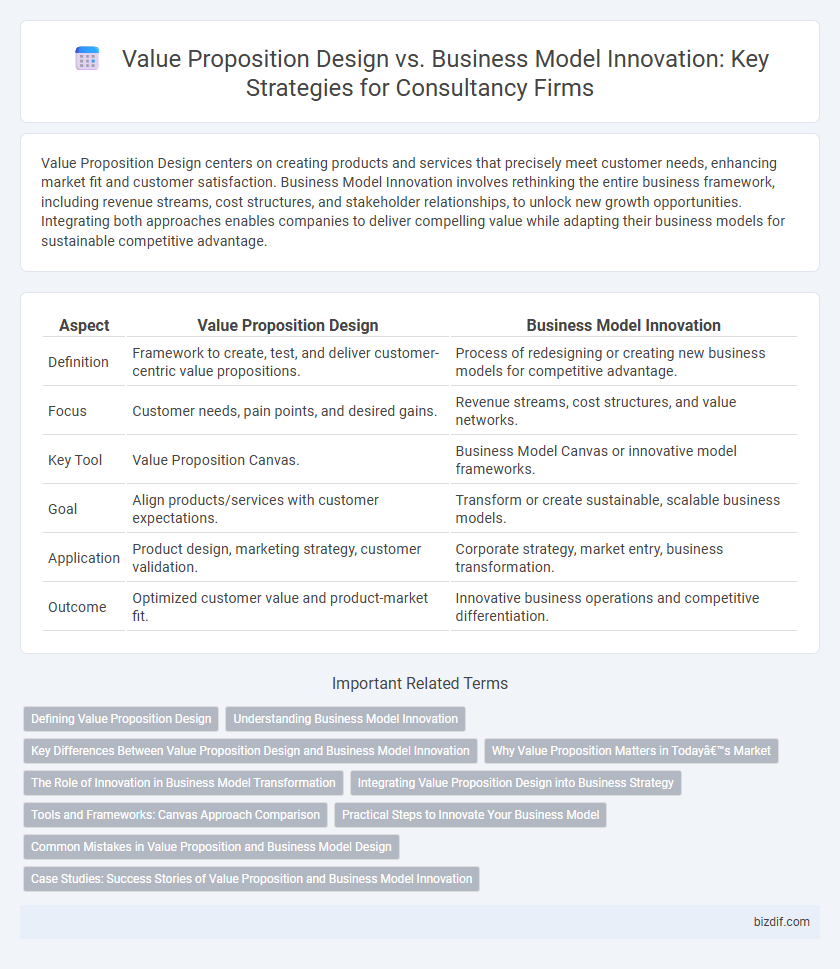Value Proposition Design centers on creating products and services that precisely meet customer needs, enhancing market fit and customer satisfaction. Business Model Innovation involves rethinking the entire business framework, including revenue streams, cost structures, and stakeholder relationships, to unlock new growth opportunities. Integrating both approaches enables companies to deliver compelling value while adapting their business models for sustainable competitive advantage.
Table of Comparison
| Aspect | Value Proposition Design | Business Model Innovation |
|---|---|---|
| Definition | Framework to create, test, and deliver customer-centric value propositions. | Process of redesigning or creating new business models for competitive advantage. |
| Focus | Customer needs, pain points, and desired gains. | Revenue streams, cost structures, and value networks. |
| Key Tool | Value Proposition Canvas. | Business Model Canvas or innovative model frameworks. |
| Goal | Align products/services with customer expectations. | Transform or create sustainable, scalable business models. |
| Application | Product design, marketing strategy, customer validation. | Corporate strategy, market entry, business transformation. |
| Outcome | Optimized customer value and product-market fit. | Innovative business operations and competitive differentiation. |
Defining Value Proposition Design
Value Proposition Design centers on identifying customer needs and tailoring products or services to deliver specific benefits that address those needs, enhancing customer satisfaction and market fit. It involves creating detailed customer profiles, articulating pain points, and mapping value maps to outline how offerings solve customer problems or create gains. This approach prioritizes clarity and precision in value articulation, forming the foundation for successful business models and fostering competitive advantage in consultancy projects.
Understanding Business Model Innovation
Business Model Innovation involves redefining core components such as value creation, delivery, and capture mechanisms to achieve competitive advantage. Unlike Value Proposition Design, which centers on tailoring products or services to customer needs, Business Model Innovation restructures the overall operational and revenue framework. This strategic shift drives sustainable growth by aligning market opportunities with innovative business architectures.
Key Differences Between Value Proposition Design and Business Model Innovation
Value Proposition Design centers on creating products and services that meet specific customer needs, emphasizing customer profiles and value maps to optimize product-market fit. Business Model Innovation involves restructuring the entire business framework, including revenue streams, channels, and partnerships, to generate new value and competitive advantage. Key differences lie in scope and focus: Value Proposition Design targets customer-centric solutions, while Business Model Innovation transforms overarching business operations.
Why Value Proposition Matters in Today’s Market
Value Proposition Design centers on creating products and services that precisely meet customer needs, directly enhancing market relevance and customer satisfaction. Business Model Innovation restructures how a company delivers value but relies heavily on a clear, compelling value proposition to drive competitive advantage. In today's market, a well-crafted value proposition differentiates brands, accelerates customer acquisition, and underpins sustainable growth amid increasing competition and shifting consumer demands.
The Role of Innovation in Business Model Transformation
Innovation acts as a critical driver in business model transformation by reshaping value proposition design to address evolving customer needs and market dynamics. Value proposition design focuses on creating tailored offerings that deliver unique benefits, while business model innovation redefines the entire framework of how value is created, delivered, and captured. The interplay of both processes enables companies to maintain competitive advantage and drive sustainable growth in rapidly changing industries.
Integrating Value Proposition Design into Business Strategy
Integrating Value Proposition Design into Business Strategy enhances innovation by aligning customer needs with strategic objectives, ensuring product-market fit and sustainable growth. This approach bridges the gap between creative value generation and practical business model execution, optimizing resource allocation and competitive advantage. Embedding value proposition frameworks into business model innovation drives more agile, customer-centric strategies that adapt to evolving market demands.
Tools and Frameworks: Canvas Approach Comparison
Value Proposition Design and Business Model Innovation both utilize canvas-based tools that facilitate structured visualization of key business elements. The Value Proposition Canvas focuses specifically on aligning customer segments with tailored value propositions, emphasizing customer jobs, pains, and gains. In contrast, the Business Model Canvas provides a holistic framework covering nine building blocks, including key partners, activities, and revenue streams, enabling comprehensive business model innovation.
Practical Steps to Innovate Your Business Model
Value Proposition Design emphasizes identifying customer needs and creating tailored solutions by mapping out value propositions, customer segments, and channels for effective delivery. Business Model Innovation involves rethinking the entire business system, including revenue streams, cost structures, and partnerships, to unlock new growth opportunities. Practical steps to innovate your business model include conducting customer interviews, prototyping value propositions, testing assumptions through MVPs, and iteratively refining business model components based on real-world feedback.
Common Mistakes in Value Proposition and Business Model Design
Common mistakes in value proposition design include unclear customer segmentation and failing to address real customer pain points, leading to irrelevant solutions. In business model innovation, pitfalls often involve neglecting scalability and ignoring the alignment between value creation and revenue streams. Overlooking market validation and insufficient iteration also hinder both value proposition effectiveness and sustainable business model transformation.
Case Studies: Success Stories of Value Proposition and Business Model Innovation
Case studies demonstrate how Value Proposition Design sharpens customer alignment by clarifying unique benefits, leading to increased market acceptance and revenue growth. Business Model Innovation reveals transformative approaches that redefine industry standards, enabling companies like Netflix to disrupt traditional markets successfully. Combining both methodologies accelerates competitive advantage by delivering tailored value through innovative business frameworks.
Value Proposition Design vs Business Model Innovation Infographic

 bizdif.com
bizdif.com